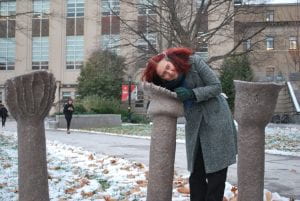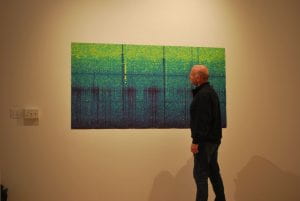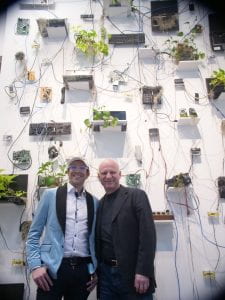We are working with an amazing range of artists and scholars in the humanities, staging performances in Cornell science buildings, outdoor sculptures, and exhibitions. Based on a project with the French artist Karine Bonneval and collaborations with Matthias Rillig, we jointly developed an interdisciplinary project on Sound of Soil; Nathaniel Stern led us into the design world; Ella Ziegler works with us on interdisciplinarity, emotions in science and art, the art-science studio, and a special project on visualization and cognition using the scientific practice of Nobel Laureate Barbara McClintock as an example; and together with Andrew Freiband from the Artists Literacies Institute a group of faculty is imagining what interdisciplinary research, teaching and outreach of tomorrow would look like.
Together with the artist Ella Ziegler, we explore in a playful way how different disciplines can work together. Using the Circular Bio-Nutrient Economy as a test case, we organized an interdisciplinary workshop at The Soil Factory in 2021.
 Karine Bonneval introduced us to the sounds of soil,- the idea that soils should ‘speak’ seemed intriguing. It started a new project on what sounds the soil could make, led by Kyle Wickings, and a dive into the sound world. For an outdoor installation as part of her exhibition VERTIMUS at Cornell in Fall 2019, she recorded sounds from three different locations across Cornell’s campus, took soil samples that she turned into sculptures and plays back the sounds through speakers,- the visitor hears soil teeming with life. Karine’s work brought together engineers, bioacousticians and natural scientists to develop new research across disciplines that would otherwise not have met.
Karine Bonneval introduced us to the sounds of soil,- the idea that soils should ‘speak’ seemed intriguing. It started a new project on what sounds the soil could make, led by Kyle Wickings, and a dive into the sound world. For an outdoor installation as part of her exhibition VERTIMUS at Cornell in Fall 2019, she recorded sounds from three different locations across Cornell’s campus, took soil samples that she turned into sculptures and plays back the sounds through speakers,- the visitor hears soil teeming with life. Karine’s work brought together engineers, bioacousticians and natural scientists to develop new research across disciplines that would otherwise not have met.
(the Cornell Chronicle reports)
This also generated thinking of how artists residencies may be organized in a scientific laboratory: Ten simple rules for hosting artists in a scientific lab.
 Nathaniel Stern, artist and professor of art history, design and engineering at the University of Wisconsin, Milwaukee, asked us whether we can pyrolyse electronic waste for him. “Pyrolyse what?” was my answer, “And why?” That was the start of an exciting journey to explore what we had never thought about, challenging us to think about our work from different perspectives. The collaboration contributed to an exhibition at the Museum of Wisconsin Art – Milwaukee in Spring 2020, called “The World After Us: Imaging Techno-Aesthetic Futures“.
Nathaniel Stern, artist and professor of art history, design and engineering at the University of Wisconsin, Milwaukee, asked us whether we can pyrolyse electronic waste for him. “Pyrolyse what?” was my answer, “And why?” That was the start of an exciting journey to explore what we had never thought about, challenging us to think about our work from different perspectives. The collaboration contributed to an exhibition at the Museum of Wisconsin Art – Milwaukee in Spring 2020, called “The World After Us: Imaging Techno-Aesthetic Futures“.
(the Cornell Chronicle reports)
(“Experiments in Art + Soil: Biochar, Media Technology, and A Collaboration Between Nathaniel Stern and Johannes Lehmann” by Jennifer Johung)
 Together with Cornell’s Johnson Museum and student groups, we organized a flag-raising event of LaToya Ruby Frazier’s FLINT, 1,105 days and counting man-made water crisis, in 2019. For more information about this event, see Mann library’s website, or on the water crisis in Flint, see The Washington Post, 16 April 2018
Together with Cornell’s Johnson Museum and student groups, we organized a flag-raising event of LaToya Ruby Frazier’s FLINT, 1,105 days and counting man-made water crisis, in 2019. For more information about this event, see Mann library’s website, or on the water crisis in Flint, see The Washington Post, 16 April 2018

